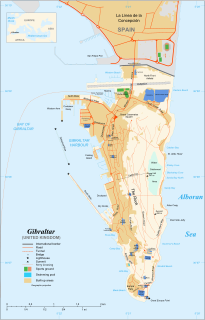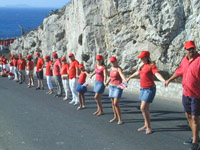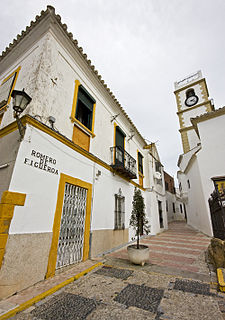The history of Gibraltar portrays how The Rock gained an importance and a reputation far exceeding its size, influencing and shaping the people who came to reside here over the centuries.

This article is about the demographic features of the population of Gibraltar, including ethnicity, education level, health of the populace, economic status, religious affiliations and other aspects of the population.

Maurice Xiberras GMH was a Gibraltarian teacher, trade unionist and politician. He was regarded as being a strong defender of British sovereignty, who believed there was no future for Gibraltar without the continuing close relationship with the United Kingdom.

The Cathedral of Saint Mary the Crowned is a Roman Catholic cathedral in Gibraltar. It is the primary centre of Catholic worship in the Diocese of Gibraltar.

San Roque is a small town and municipality in the south of Spain. It is part of the province of Cádiz, which in turn is part of the autonomous community of Andalusia. San Roque is situated a short way inland of the north side of the Bay of Gibraltar, just to the north of the Gibraltar peninsula. The municipality has a total surface of 145 km2 with a population of approximately 25,500 people, as of 2005. Its name is Spanish for Saint Roch, a Christian saint who was revered in a shrine dating back to 1508 that predates the foundation of the town.

The Gibraltar territory currently contains an 800-metre (2,625 ft) long section of the isthmus that links the Rock with mainland Spain. Spain does not acknowledge British sovereignty over Gibraltar beyond the fortified perimeter of the town as at 1704. The United Kingdom claims the southern part of the isthmus on the basis of continuous possession over a long period.

The coat of arms of Gibraltar was first granted by a Royal Warrant passed in Toledo on 10 July 1502 by Isabella I of Castile during Gibraltar's Spanish period. The arms consists of an escutcheon and features a three-towered red castle under which hangs a golden key.

The military history of Gibraltar during World War II exemplifies Gibraltar's position as a British fortress since the early 18th century and as a vital factor in British military strategy, both as a foothold on the continent of Europe, and as a bastion of British sea power. During World War II, Gibraltar served a vital role in both the Atlantic Theatre and the Mediterranean Theatre, controlling virtually all naval traffic into and out of the Mediterranean Sea from the Atlantic Ocean.

The Gibraltar Constitution Order 1969 was published on 30 May 1969 as an Order in Council.

The Gibraltarians are a cultural group native to Gibraltar, a British overseas territory located near the southernmost tip of the Iberian Peninsula at the entrance to the Mediterranean Sea.

Juan Romero de Figueroa was a Spanish Roman Catholic priest, in charge of the Parish Church of St. Mary the Crowned during the last years of Gibraltar's Spanish period and first ones of the British period, until his death. He remained at his post even after the territory's capture by an Anglo-Dutch fleet in 1704 on behalf of the Archduke Charles, pretender to the Spanish throne in the War of the Spanish Succession, when most of its population abandoned Gibraltar.
Mesod Benady MBE is a Gibraltarian historian of Sephardic Jewish descent. He currently lives in Grendon, Northamptonshire in the United Kingdom.
The Memorandum by Her Majesty's Government on the Report of the Constitution Committee, or the Hattersley Memorandum for short, dated 26 June 1976, was the answer of the Labour British Government to proposed constitutional changes in Gibraltar ruling out the possibility of integration of Gibraltar with the United Kingdom.
"The Doves" was the pseudonym under which a group of six Gibraltarian lawyers and businessmen published a letter on 15 March 1968 in the Gibraltar Chronicle advocating a political settlement with Spain to solve the disputed status of Gibraltar.

Our Lady of Europe is a title given to the Blessed Virgin Mary patroness of Gibraltar and protectress of Europe. The entire European continent was consecrated under the protection of Our Lady of Europe in the early 14th century from the Shrine in Gibraltar where devotion continues to this day, over 700 years on.

Dorothy May Ellicott, OBE, GMH, JP (1901–1990), was a Gibraltarian historian and politician.

Capital punishment in Gibraltar included public execution in the nineteenth century until 1864. The last sentence of death was passed in 1952. Under British law, capital punishment was almost abolished in 1965, in line with British practice. It was entirely abolished in 2002 along with all other British Overseas Territories.

King's Chapel is a small chapel in the British Overseas Territory of Gibraltar. It is located at the southern end of Main Street and adjoins the Governor of Gibraltar's residence, The Convent. What nowadays is King's Chapel was the first purpose-built church to be constructed in Gibraltar. Originally part of a Franciscan friary, the chapel was built in the 1530s but was given to the Church of England by the British after the capture of Gibraltar in 1704. It was badly damaged in the late 18th century during the Great Siege of Gibraltar and in the explosion of an ammunition ship in Gibraltar harbour in 1951, but was restored on both occasions. From 1844 to 1990 it served as the principal church of the British Army in Gibraltar; since then it has been used by all three services of the British Armed Forces.
Fig Tree Cave is a cave in the British Overseas Territory of Gibraltar. It is located on the eastern cliffs of the Rock of Gibraltar, not far from Martin's Cave within the Upper Rock Nature Reserve.





















